Paiements numériques
Les technologies numériques transforment la manière dont nous répondons aux urgences. Les innovations sont multiples : elles concernent l’identification des personnes ayant droit à une aide, la collecte des données pour les évaluations et le suivi ou encore la communication aux communautés affectées par la crise. Les systèmes de paiement numérique, dont les appareils mobiles, les coupons électroniques et les cartes, lorsqu’ils sont utilisés de manière appropriée, peuvent accélérer, sécuriser et optimiser l’assistance, la rendant également plus inclusive. Toutefois, le volume de données personnelles que nous collectons, stockons et partageons augmentant, nous devons nous assurer que nos systèmes de protection des données restent pertinents et veiller à comprendre et atténuer les risques associés aux nouvelles technologies.
Contenu associé

Podcast: Is informed consent possible in humanitarian CVA?
Podcast
Episode 2 of the CashCast tackles data responsibility with Amos Doornbos, Linda Raftree, James Eaton Lee and Ric Tighe

Consent and Ownership in the Shift to Digital Cash and Voucher Assistance
Blog Post
Part of committing to cash and voucher assistance (CVA) is committing to going digital and collecting data. While they are two different things, they are deeply intertwined. And while an organisation can ‘go digital’ without cash programmes, it’s nearly impossible to commit to cash programmes in the long term without going digital. Yes, it is true we’ve done cash and voucher programmes...
Contenu récent

Payment Mechanisms and Anti-Poverty Programs: Evidence from a Mobile Money Cash Transfer Experiment in Niger
Report
Cash transfers have become an increasingly important component of social protection policies in both developed and developing countries. While such programs are often implemented electronically in developed countries, in many developing countries with weak financial infrastructure, such transfers are...
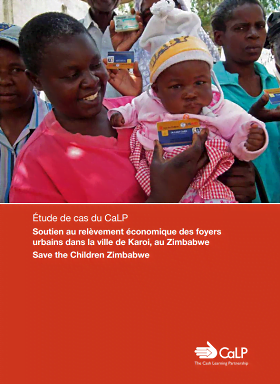
Étude de cas du CALP Network – Soutien au relèvement économique des foyers urbains dans la ville de Karoi, au Zimbabwe
Rapport
Dans la zone urbaine de Karoi, au Zimbabwe, Save the Children a allié des programmes d’argent contre travail au soutien des moyens de subsistance pour répondre aux besoins alimentaires immédiats et soutenir le relèvement économique des familles en situation de pauvreté. Le projet a utilisé des...
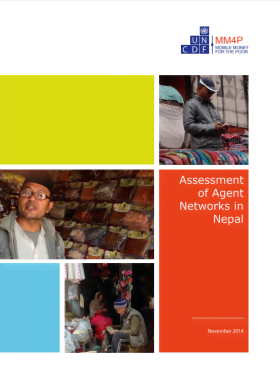
Assessment of Agent Networks in Nepal
Report
This report focuses on assessing the existing agent networks in Nepal, so that the correct steps can be taken to popularise both access to and use of financial services through bank-led agent banking. After the release of electronic banking regulations in 2012, many financial institutions began...
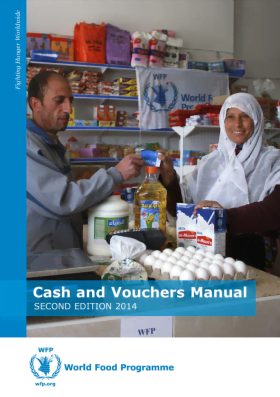
Cash and Vouchers Manual – Second edition
Guidelines and Tools
This second edition of the Cash and Vouchers Manual captures the latest corporately endorsed business processes and procedures, providing the most up-to-date tools (i.e. analytical, assessment, monitoring) that have been developed through close intra-departmental collaboration between Headquarters...

Facteurs affectant l’optimisation des coûts des transferts électroniques dans les programmes humanitaires
Rapport
Ce travail de recherche propose une méthodologie pour évaluer les coûts et présente des études de cas détaillées sur les coûts liés à l’exécution des récents programmes faisant appel aux transferts monétaires en situation d’urgence menés au Kenya et en Somalie, s’inspirant des...
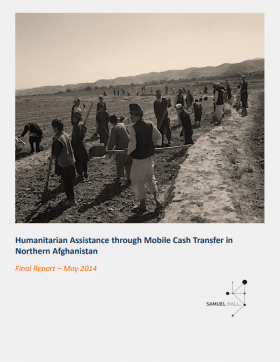
Humanitarian Assistance through Mobile Cash Transfer in Northern Afghanistan: An evaluation of a DFID pilot project in Faryab, Jawzjan, and Samangan
Report
In response to the 2011 severe drought that pushed vulnerable rural households into food insecurity in 14 provinces of Northern Afghanistan, DFID has committed to address emergency needs in northern Afghanistan with nutrition, food security and farming inputs. Samuel Hall Consulting, a Kabul-based...

Understanding the Demand for Financial Services in Nepal
Report
Nepal has a unique geography consisting of mountains, hills and Terai, which makes it difficult for any financial institution to provide financial services to every part of the country. Formal and informal financial service providers have been attempting to reach more customers at various levels and...
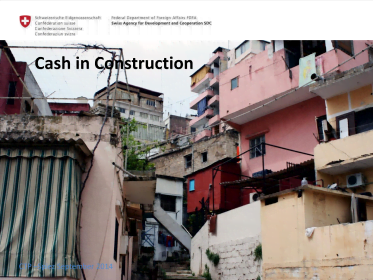
Cash in Construction
Presentation
This Powerpoint was used by SDC during a workshop on CTP and shelter/construction that took place in mid 2014. Click here to download a short introduction Powerpoint on Cash and Shelter from the same event.
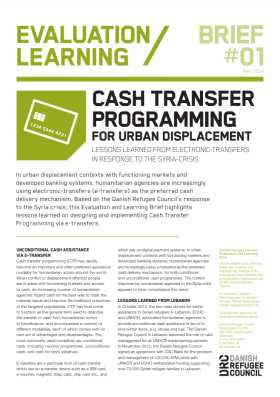
Cash Transfer Programming for Urban Displacement
Policy paper
In urban displacement contexts with functioning markets and developed banking systems, humanitarian agencies are increasingly using electronic-transfers (e-transfers) as the preferred cash delivery mechanism. Based on the Danish Refugee Council’s response to the Syria crisis, this Evaluation and...

Information and communications technology response to the Liberia ebola crisis
Report
An information and communication technology assessment recently conducted in Liberia by NetHope and USAID addresses the potential for digital payments in the response to Ebola. The documents looks into the digital payments landscape, describing the banking sector, use of mobile money and remittance firms....

Testing Branchless Banking to Deliver Cash Transfers in Nepal
Policy paper
The Human Development Social Protection Pilot (HDSPP) is a sub-project of the joint UNDP-UNCDF Local Governance and Community Development Program (LGCDP). It has been initiated in two far-western districts in Nepal, Kanchanpur and Dhadheldura and it is being implemented by the Ministry of Federal Affairs...
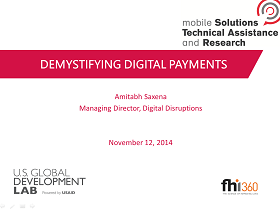
Demystifying Payments – mStar
Report
In its simplest form, a payment is any exchange of value between two parties, where usually Party A offers a form of currency in exchange for a good or service provided by Party B. The advent of nation-states issuing fiat currency, such as paper bills and bronze coins, which unlike gold or silver...
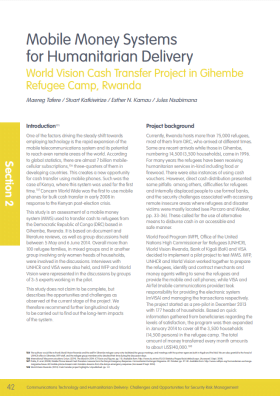
Mobile Money Systems for Humanitarian Delivery: World Vision cash transfer project in Gihembe refugee camp, Rwanda
Report
One of the factors driving the steady shift towards employing technology is the rapid expansion of the mobile telecommunications system and its potential to reach even remote areas of the world. According to global statistics, there are almost 7 billion mobilecellular subscriptions, three-quarters of them...
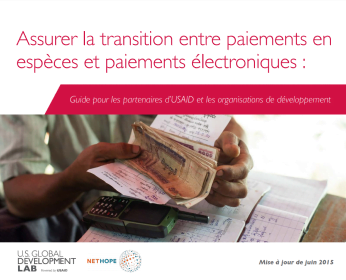
Assurer la Transition Entre Paiements en Espèces et Paiements Électroniques: Guide pour les partenaires d’USAID et les organisations de développement
Guides et outils
Cette boîte à outils a été créée pour les organisations non gouvernementales de secours et de développement pour les guider dans leur transition de l’utilisation des paiements en espèces aux paiements électroniques dans tous les flux de paiements opérationnels et de programme. Il est destiné...

E-transfers in Emergencies: Implementation support guidelines
Guidelines and Tools
Electronic transfers, or e-transfers, are a form of value transfer that relies on digital payment systems. The great many benefits they can realise for aid recipients and aid agencies alike in terms of increased security, convenience, privacy, speed, reduced operational/transaction costs and logistics,...
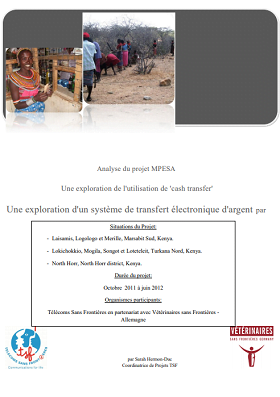
Analyse du projet MPESA, Une exploration de l’utilisation de ‘cash transfer’
Rapport
Safaricom Limited, opérateur de services mobiles au Kenya, a lancé en 2007 un système de transfert d’argent par mobile: M-PESA. Ce système permet aux utilisateurs d’envoyer ou de recevoir de l’argent sur leur carte SIM Safaricom. Télécoms sans Frontières et Vétérinaires sans Frontières –...
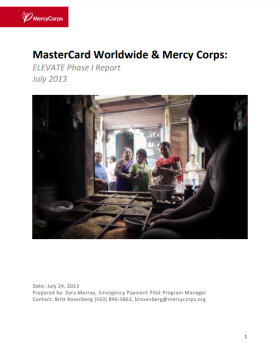
MasterCard Worldwide and Mercy Corps: ELEVATE phase I report
Report
The Nepal pilot focused on testing several key stages in the deployment of mobile vouchers, including the following: Identify a technology partner, Customize a mobile voucher platform, and Use the platform to distribute goods to people in need. Two different types of mobile vouchers (SMS and smartphone...
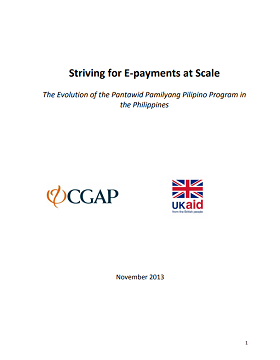
Striving for E-Payments at Scale in the Philippines
Report
As the Philippines experienced economic growth in the early 2000s, it still saw a rise in poverty. The Pantawid Pamilyang Pilipino Program (4Ps) is a conditional cash transfer program that aims to provide short-term poverty alleviation for poor households. The program emerged out of the country’s...
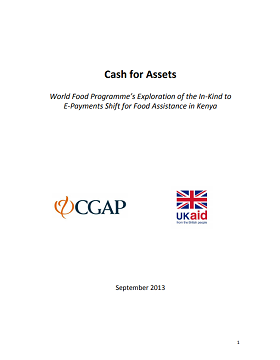
Shifting Food Assistance in Kenya to E-Payments
Report
The shift away from in-kind aid as the preferred mechanism for humanitarian assistance has contributed to the rise of cash transfers in Kenya. In 2008, the World Food Programme (WFP) for the first time shifted strategically from a food aid to a food assistance strategy, recognizing new and diverse ways in...

E-Payments in Uganda with Limited Infrastructure
Report
The 2005 Uganda Chronic Poverty Report argued that households in chronic poverty show a range of deficits that include deficient consumption and malnutrition, limited access to health and education, and limited voice and influence. For many of these households social exclusion reinforces their...